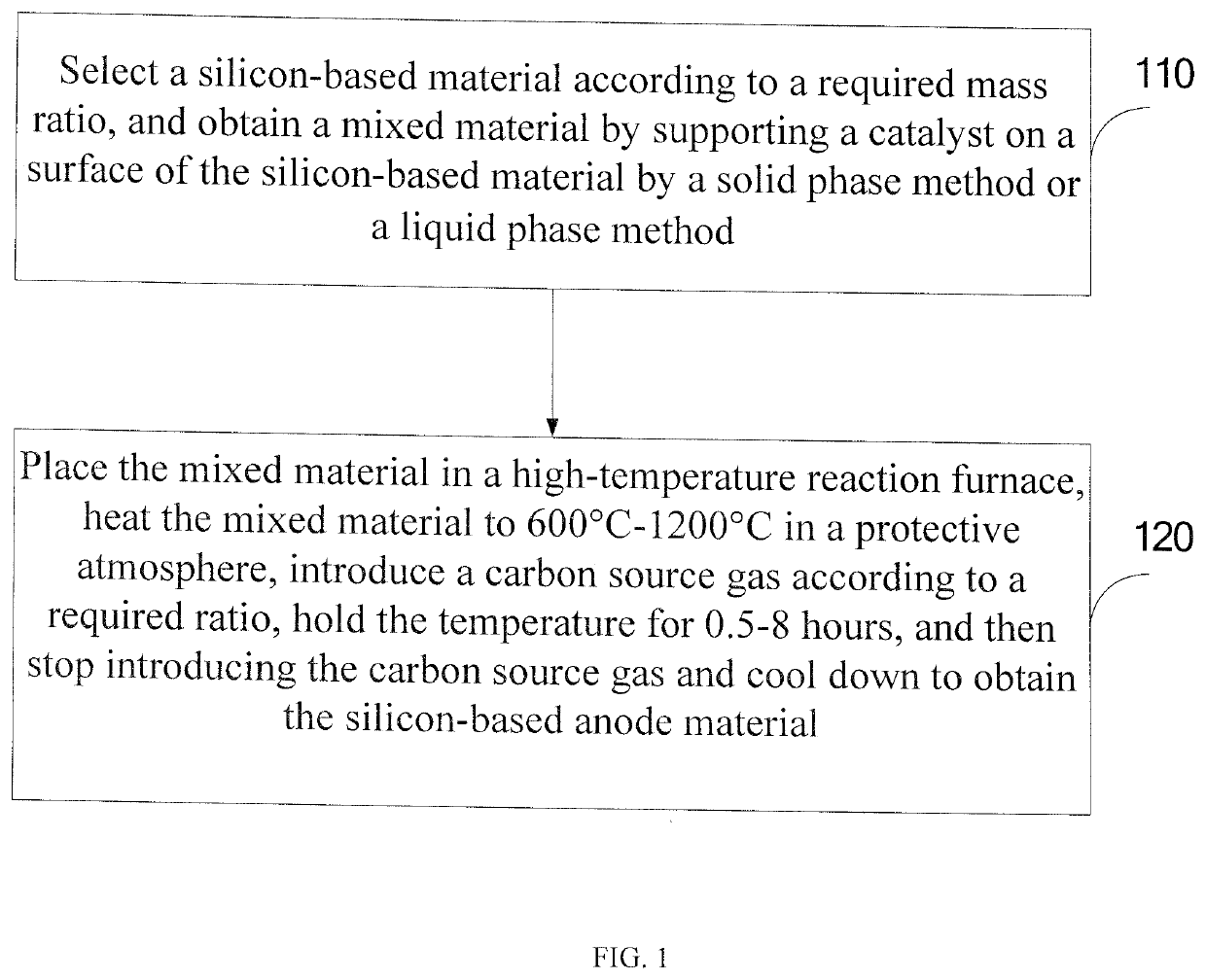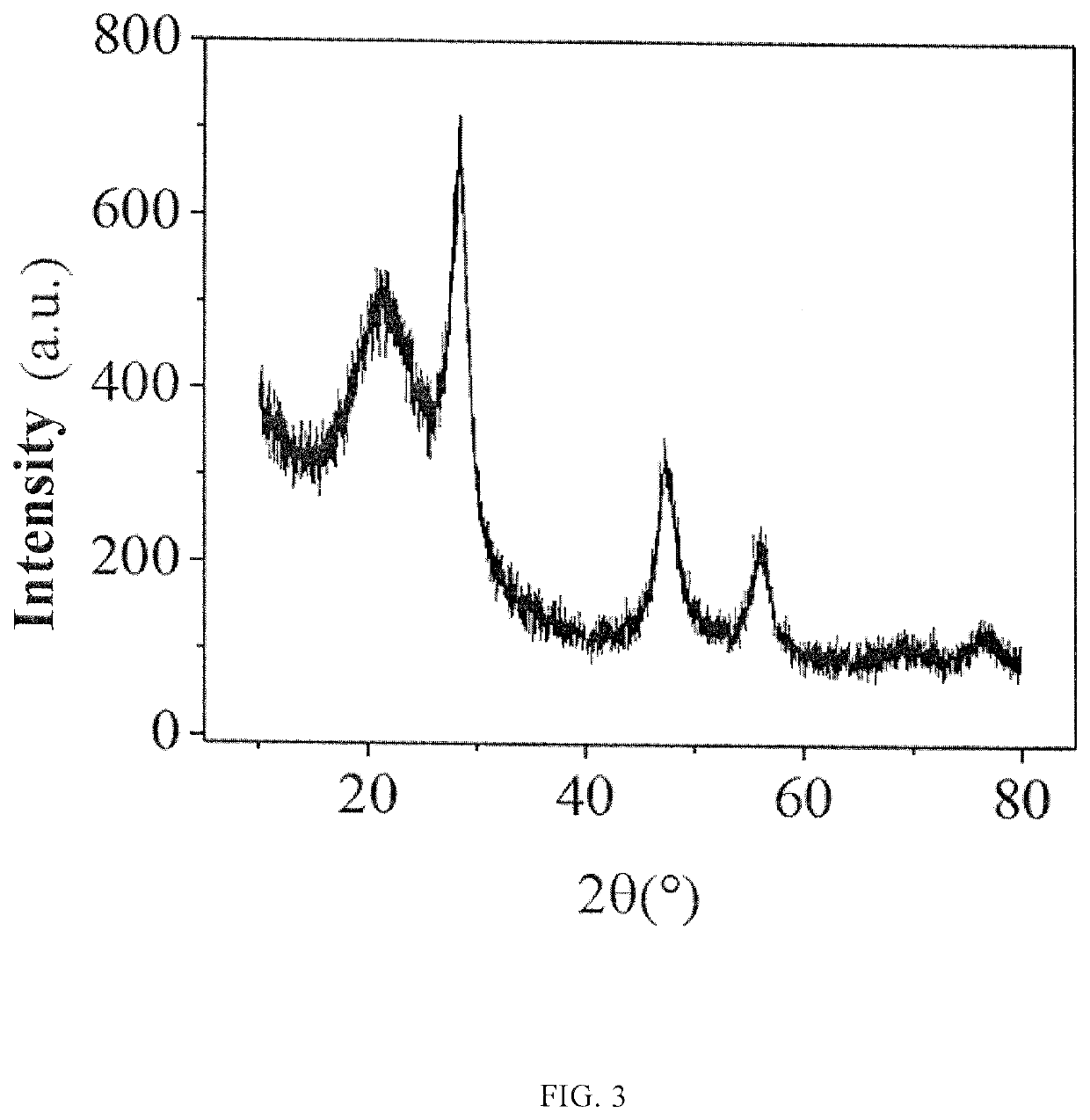Silicon-based anode material for lithium-ion battery, preparation method therefor, and battery
a lithium-ion battery and anode material technology, applied in the field of lithium-ion battery materials, can solve the problems of volume expansion and unstable interface reactions during the cycle, the theoretical specific capacity of 372 mah/g cannot meet people's increasing requirements for energy density, and the rapid decay of the cycle, etc., to achieve good rate performance, stable structure, and excellent cycle performance
- Summary
- Abstract
- Description
- Claims
- Application Information
AI Technical Summary
Benefits of technology
Problems solved by technology
Method used
Image
Examples
embodiment 1
[0062]This embodiment provides a specific preparation method of a silicon-based anode material for a lithium-ion battery, including:
[0063]First, thoroughly mixing commercial product of Silicon monoxide powder with an aqueous solution of ferric chloride, and spray drying to obtain the catalyst-supported Silicon monoxide powder; wherein the weight fraction of ferric chloride is 0.05%; and
[0064]Second, placing the catalyst-supported Silicon monoxide powder in a high-temperature rotary furnace, heating the catalyst-supported Silicon monoxide powder to 900° C. under a mixed gas (Ar:H2=1:0.1), introducing acetylene gas of which the volume is equivalent to that of hydrogen, holding the temperature for 4 hours, then stopping introducing acetylene gas, and cooling down to obtain the Silicon monoxide composite material with carbon nanotubes grown in situ.
[0065]The SEM experiment of the disclosure was performed on an S-4800 scanning electron microscope, and the same operation was applied to th...
embodiment 2
[0072]This embodiment provides a specific preparation method of a silicon-based anode material, including:
[0073]First, thoroughly mixing commercial product of Silicon monoxide powder with nano iron oxide in a high-speed VC machine, thus obtaining a catalyst-supported Silicon monoxide powder; wherein the weight fraction of nano iron oxide is 0.05%; and
[0074]Second, placing the catalyst-supported Silicon monoxide powder in a high-temperature rotary furnace, heating the catalyst-supported Silicon monoxide powder to 900° C. under a mixed gas (Ar:H2=1:0.1), introducing acetylene gas of which the volume is equivalent to that of hydrogen, holding the temperature for 4 hours, then stopping introducing acetylene gas, and cooling down to obtain the Silicon monoxide composite material with carbon nanotubes grown in situ.
[0075]The Raman spectrum of the material obtained in this embodiment is shown in FIG. 7. It can be seen from FIG. 7 that there is a bulge of amorphous silicon at 475 cm−1;
[0076...
embodiment 3
[0078]This embodiment provides a specific preparation method of a silicon-based anode material, including:
[0079]First, thoroughly mixing commercial product of Silicon monoxide powder with nano metallic copper in a high-speed VC machine, thus obtaining a catalyst-supported Silicon monoxide powder; wherein the weight fraction of nano metallic copper is 0.05%; and
[0080]Second, placing the catalyst-supported Silicon monoxide powder in a high-temperature rotary furnace, heating the catalyst-supported Silicon monoxide powder to 1000° C. under a mixed gas (Ar:H2=1:0.1), introducing methane gas of which the volume is equivalent to that of hydrogen, holding the temperature for 4 hours, then stopping introducing methane gas, and cooling down to obtain the Silicon monoxide composite material with carbon nanotubes grown in situ.
[0081]The SEM image of the Silicon monoxide composite material with carbon nanotubes grown in situ obtained in this example is shown in FIG. 9. It can be seen from that ...
PUM
| Property | Measurement | Unit |
|---|---|---|
| Temperature | aaaaa | aaaaa |
| Time | aaaaa | aaaaa |
| Angle | aaaaa | aaaaa |
Abstract
Description
Claims
Application Information
 Login to View More
Login to View More - R&D
- Intellectual Property
- Life Sciences
- Materials
- Tech Scout
- Unparalleled Data Quality
- Higher Quality Content
- 60% Fewer Hallucinations
Browse by: Latest US Patents, China's latest patents, Technical Efficacy Thesaurus, Application Domain, Technology Topic, Popular Technical Reports.
© 2025 PatSnap. All rights reserved.Legal|Privacy policy|Modern Slavery Act Transparency Statement|Sitemap|About US| Contact US: help@patsnap.com



